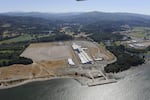
The site at the Port of Kalama where NW Innovation Works is proposing a 90-acre methanol plant.
NW Innovation Works
An environmental analysis released Wednesday by the Washington Department of Ecology found additional sources of greenhouse gas emissions from the $2 billion methanol project proposed on the lower Columbia River.
Ecology found the project would increase the state’s greenhouse gas emissions by almost 1 million tons, making it one of the 10 largest sources of emissions in Washington.
The agency found the project could generate more greenhouse gas emissions from the extraction of natural gas than previously estimated and that it would lead to methanol being burned globally as fuel.
The Chinese government-owned company NW Innovation Works has proposed building what would be one of the world’s largest methanol plants in Kalama, Washington. It said the plant would turn fracked natural gas from Canada into methanol that would be shipped to China to make plastics. Plans include a 3-mile pipeline for transporting natural gas.
However, as OPB reported last year, the company has suggested to potential investors that it could sell its methanol for fuel, which could change the climate impacts of the project.
The report says that methanol made in Kalama could produce fewer greenhouse gas emissions than other methanol plants elsewhere that use coal or less efficient natural gas sources. However, Ecology found about half as many greenhouse gas emission savings than were outlined in a previous analysis.
Ecology is using this analysis to make a permitting decision, and it could still decide to deny the permit or change the required mitigation based on these findings.
The agency contracted with consulting firm TRC to complete a supplemental environmental impact statement for the project after finding earlier studies didn’t consider all of its potential greenhouse gas emissions and contributions to climate change.
The new report looks explicitly at the impacts of the project based on how the methanol would be used with the assumption that some of it would be burned for fuel. It finds that burning methanol for fuel creates more emissions than using it to make plastics, and that the project will inevitably lead to more methanol being burned as fuel because it would increase methanol supply globally.
The analysis also tallies greenhouse gas emissions from the drilling and transportation of natural gas for the facility, including emissions from gas that escapes from gas wells and pipelines. Those emissions were found to be higher than what was calculated in a previous environmental impact statement.
Related: Controversial Kalama methanol plant may be misleading public, regulators
According to Neal Caudill, senior planner with Washington Ecology’s Air Quality Program, the new analysis estimated the project would be associated with a total of 4.6 million metric tons of greenhouse gas every year while the previous analysis found that total to be just 2.6 million metric tons.
Stuart Clark, special assistant to the director at Washington Ecology, said the new analysis still concludes that building the Kalama facility could reduce global emissions because it would produce methanol from a cleaner and more efficient source of fuel than other production plants.
“If you build Kalama, it shows those emissions could potentially be less than if you don’t build it because other facilities that make methanol tend to have higher greenhouse gas footprints,” Clark said.
However, he said, they found fewer greenhouse gas savings over competing methanol production plants around the world than the earlier analysis did. So, the net savings of building the plant in Kalama would be more like 6 million metric tons rather than 11.5 million metric tons in the previous analysis.
Opponents of the methanol plant with environmental groups decried this logic, arguing it is speculative to assume the methanol from Kalama would replace methanol made elsewhere.
“The urgency of our climate crisis demands the highest level of scrutiny, and we cannot allow massive new fracked gas projects to move forward based on speculation and the faint hope of theoretical emission reductions,” said Alyssa Macy, CEO of Washington Environmental Council and Washington Conservation Voters.
Macy said the methanol plant poses “potentially catastrophic climate impacts” and joined others in asking Ecology to deny the company’s permit.
NW Innovation Works spokesman Kent Caputo called the analysis “an impressive piece of work” and said it is “generally consistent” with the company’s earlier analysis that found its project would have a larger net reduction in global greenhouse gas emissions.
Caputo noted that his company still plans to mitigate or offset all of the project’s greenhouse gas emissions in the state of Washington.
“Functionally speaking, it’s not a big difference for us,” he said. “We’re going to mitigate for those in-state emissions, and we’re going to have a massive impact globally for greenhouse gas emission displacement.”
The state’s decision to do additional environmental analysis delayed a key permit for the controversial project, and opponents with conservation and public health groups have sued the federal government over previously approved permits for the project.
Washington Ecology will be taking public comments on the draft supplemental environmental impact statement through Oct. 2 and will host three public hearings at 1 p.m. Sept. 17, and on Sept. 22 at 10 a.m. and 6 p.m.
